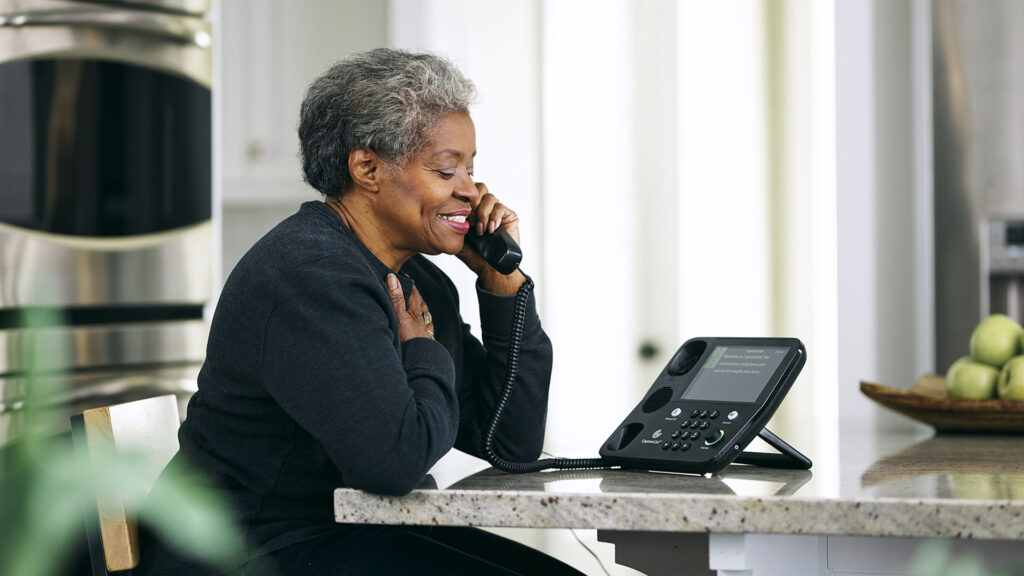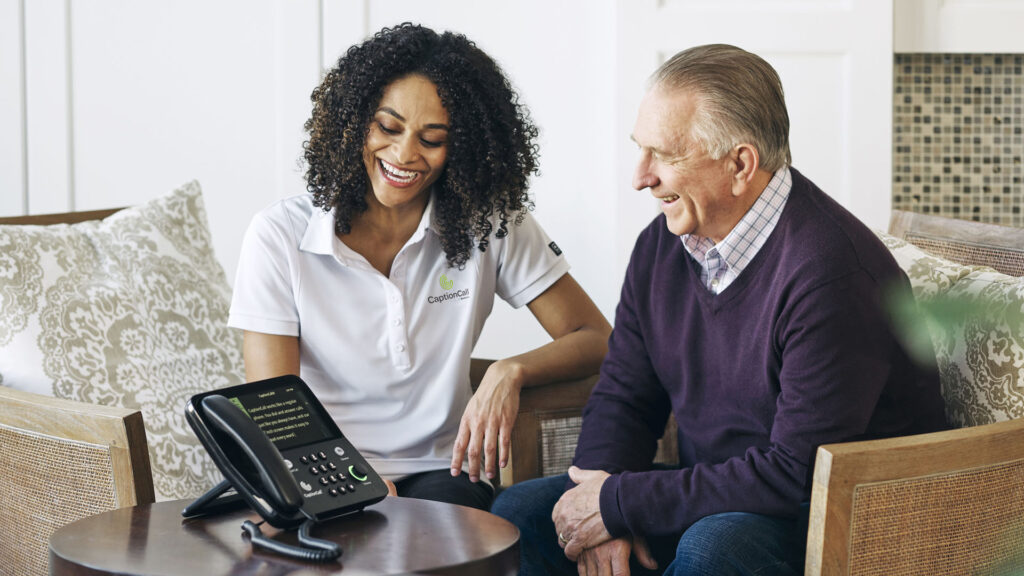Captioned Phones for Seniors

As we age, communication can become a challenge for many of us. While almost one out of every six American adults have some degree of hearing loss, it’s more prevalent with age. More than 30% of people 65 and older sustain hearing loss, while approximately 40% of those 75 and older experience hearing loss. Adequate communication for seniors with hearing loss is crucial for maintaining strong social connections and emotional well-being.
Captioned phones for seniors can be a lifeline. Aging comes with many major life changes, such as retirement, friend and family losses, and aging-associated illnesses, which can shorten a senior’s lifespan. With captioned phones, however, seniors can remain independent without needing to rely on others to facilitate communication. Taking advantage of these telecommunication devices can also provide a semblance of safety (through alerts and 911 calls).
Furthermore, a Pew Research study shows that more than 27% of US adults ages 60 and older live alone, the highest of any country around the world. Religious and cultural factors, as well as geographic location and socioeconomic status, can affect whether you’re more likely to be lonely as you age. The rise in telecommunication technology has made it easier for seniors to maintain contact with loved ones.
Whether you struggle to understand your family or to have an important conversation with your doctor, closed caption phones can bridge that communication gap and help you maintain strong social ties.
What are Captioned Phones?
A captioned phone is a telecommunication device that looks like a typical landline phone, but with a display screen above the keypad. The device transcribes the call in real-time while you listen and read the screen, enhancing your overall experience of the phone call.
Benefits of Captioned Phones for Seniors
Following the Federal Communications Commission’s (FCC) approval of closed captioning for TV in 1976, funding to further telecommunication access for the Deaf and hard-of-hearing people continued with the Internet Protocol Captioned Telephone Service (IP CTS) between 2000 and 2007, along with video relay services. The FCC funds these telephone and internet telephone services through the Telecommunication Relay Services (TRS) Fund. It was only in 2003 when the first captioned telephone was released.
With these three benefits, captioned phones can be an effective booster of psychological health in seniors:
- Confidence: Using a captioned phone enables seniors with hearing loss to connect with anyone freely. Unlike before, they no longer need to avoid phone calls out of fear of missing any part of the conversation.
- Decreased social isolation: Easily communicating with loved ones at any time has proven to ease social isolation in seniors.
- Better quality of life: As the telephone has been the central communication method throughout seniors’ lives using a captioned phone easily enhances their overall well-being.
Best Captioned Phone Service for Landline and Mobile
Sorenson provides a range of telecommunication solutions aimed at Deaf and hard-of-hearing people, which can also benefit seniors with hearing loss. Here, we provide an overview of telecommunication products useful for seniors.
CaptionCall

CaptionCall is available for landline and mobile use and is no cost for people whose hearing loss makes captions necessary to use the phone. It’s the #1 phone call captioning service in America. Its practical features make it among the best captioned phones on the market.
The CaptionCall landline phone captioning service has several features benefiting seniors:
- Hearing aid compatible
- Smooth scrolling captions (thanks to SilkScroll® technology)
- Adjustable settings
- Saved conversation and voice message transcripts
- Stored contact list
- Caption 911 calls
- English and Spanish captions
You can download CaptionCall Mobile (formerly Olelo) for Android and iOS. Some of the nifty features include:
- High accuracy
- Real-time captions
- Saved conversation transcripts
- Captioned voicemail
- English and Spanish captions
- Adjustable text size and color
You can download CaptionCall Mobile for iOS 15 and later, and Android 9 and later.
As a CaptionCall Mobile user myself, it feels very much like texting someone because the screen also displays your side of the conversation. You can switch the colors and text size, which I like. I’d rate the accuracy of the other person’s speech at 90%, complete with periods and commas so you’re reading complete sentences.
How to Qualify for a No-Cost Captioned Phone Service
A senior can qualify for CaptionCall service at no cost if they have hearing loss and need captions to communicate over the phone. The Telecommunication Relay Service (TRS) covers the cost of all captioned phone service for qualified people, and CaptionCall provides the caption phone or mobile app at no cost as part of your service.
To request CaptionCall service for your home or work phone, visit the Sorenson site to fill out a form. It’s not necessary for you to have landline phone service or high-speed internet.
You have three options for delivery and installation of CaptionCall:
- Red Carpet Service (in-person installation) and training
- Remote installation (customer installs with live trainer on the phone)
- DIY installation (with virtual instructions)
How to Choose the Right Captioned Phone
When you’re selecting a captioned phone, look for one that’s practical, user friendly, and fits your specific needs. Here’s what to consider:
- Read customer reviews. Choose a captioned phone based on user satisfaction and overall value.
- Determine your level of comfort with technology. If you’re not tech savvy, opt for a simple interface and a few features. You use CaptionCall just like a landline phone except you’re reading the conversation.
- Decide if you need landline, mobile, or both. You can use both. However, many people tend to use one more than the other. What you choose will depend on your lifestyle and your preferred communication mode. With CaptionCall and CaptionCall Mobile, you can have caption phone service at home, at an office, and on-the-go.
- Consider emergency features. Some phones come equipped with alert buttons and location tracking. These features can give peace of mind to you and your family members. CaptionCall and CaptionCall Mobile caption 911 calls and can help direct emergency services to your location.
- Look for built-in accessibility features. CaptionCall’s features include adjustable text size and color, and hands-free speakerphone.
- Quality customer service. Sorenson delivers high-quality customer service by offering Red Carpet Service for CaptionCall in-person installation and activation. Even better is the 100% satisfaction guarantee. If you don’t like your phone and want to return it, you can do so at no cost. Sorenson’s customer service is based in the U.S., meaning no struggling to understand people overseas.
Conclusion
We know that loneliness among seniors can significantly impact their mental and physical health, creating serious repercussions for global health. Captioned phone service can be a lifeline for seniors with hearing loss, helping them maintain social ties, independence, and stave off social isolation.
When choosing a captioned phone, it’s important to consider factors such as vision, emergency features, and familiarity with technology that meet your unique needs and preferences. The right captioned phone can breed self-confidence and an overall sense of well-being.
To learn more about the benefits of captioned phone service, review CaptionCall today. Take that first step toward improving your communication and well-being.

